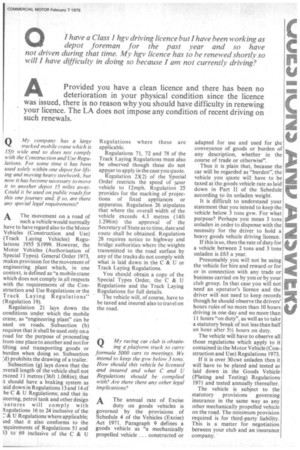Q My racing car club is obtaining a platform truck
Page 75

If you've noticed an error in this article please click here to report it so we can fix it.
to carry formula 5000 cars to meetings. We intend to keep the gvw below 3 tons. How should this vehicle be licensed and insured and what C and U Regulations should be complied with? Are there there any other legal implications?
AThe annual rate of Excise duty on goods vehicles is governed by the provisions of Schedule 4 of the Vehicles (Excise) Act 1971. Paragraph 9 defines a goods vehicle as "a mechanically propelled vehicle . .. constructed or adapted for use and used for the conveyance of goods or burden of any description, whether in the course of trade or otherwise".
Thus it is plain that, because the car will be regarded as "burden"; the vehicle you quote will have to be taxed at the goods vehicle rate as laid down in Part II of the Schedule according to its unladen weight.
It is difficult to understand your statement that you intend to keep the vehicle below 3 tons gvw. For what purpose? Perhaps you mean 3 tons unladen in order to dispense with the necessity for the driver to hold a heavy goods vehicle driving licence If this is so, then the rate of duty for a vehicle between 2 tons and 3 tons unladen is £63 a year.
Presumably you will not be using the vehicle for hire and reward or for or in connection with any trade or business carried on by you or by your club group. In that case you will not need an operator's licence and the driver will not need to keep records though he should observe the drivers' hours rules of no more than 10 hours driving in one day and no more than 11 hours "on duty", as well as to take a statutory break of not less than half an hour after 51/2 hours on duty.
The vehicle will have to observe all those regulatio'ns which apply to it contained in the Motor Vehicle (Construction and Use) Regulations 1973.
If it is over 30 cwt unladen then it will have to be plated and tested as laid down in the Goods Vehicle (Plating and Testing) Regulations 1971 and tested annually thereafter.
The vehicle is subject to the statutory provisions governing insurance in the same way as any other mechanically propelled vehicle on the road. The minimum provision required is for third-party liability. This is a matter for negotiation between your club and an insurance company.












































































































































